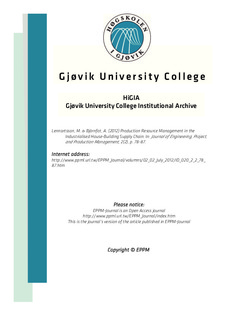| dc.contributor.author | Lennartsson, Martin | |
| dc.contributor.author | Björnfot, Anders | |
| dc.date.accessioned | 2013-02-22T09:30:35Z | |
| dc.date.available | 2013-02-22T09:30:35Z | |
| dc.date.issued | 2012 | |
| dc.identifier.citation | Lennartsson, M. & Björnfot, A. (2012) Production Resource Management in the Industrialised House-Building Supply Chain. In: Journal of Engineering, Project, and Production Management, 2(2), p. 78-87. | no_NO |
| dc.identifier.issn | 2221-6529 | no_NO |
| dc.identifier.uri | http://hdl.handle.net/11250/142593 | |
| dc.description | This is the journal’s version of the article published in EPPM-Journal: http://www.ppml.url.tw/EPPM_Journal/volumns/02_02_July_2012/ID_020_2_2_78_87.htm | no_NO |
| dc.description.abstract | Industrialised house-building suppliers must learn to see how the lack of resource management disrupt the
synchronisation of their production processes both upstream (e.g. capability to forecast material consumption) and
downstream (e.g. order delivery Just-in-Time). In contrast to focus on workflow as is more common in construction,
Systematic Production Analysis (SPA) is a tool capable of providing a more robust production process in terms of better
resource characterisation and predictability. A roadmap model, composed of six steps, has been developed for simple
introduction of SPA. The model is a straightforward way of classifying the production system in terms of impacting
resource and parameters attributing to production loss (scrap or downtime). The applicability of SPA is analysed through
a pilot case study at a patio door manufacturer. Two main response parameters emerged related to scrap; surface and
dimension errors of the work piece material (wood). An objective function was formulated to reduce the scrap without
increasing the total cost of the work piece material. It was suggested that the case company evaluates Engineering Wood
Products (EWP) leading to a more robust production process (less scrap), but in turn increasing the initial cost of the
work piece material. Other potential measures are purchasing new processing tools, investing in new machinery or
educating workers which all, directly or indirectly, lead to reduced scrap. Consequently, proper management of
production resources will improve their predictability and in turn improve production control. | no_NO |
| dc.description.abstract | Peer reviewed | no_NO |
| dc.language.iso | eng | no_NO |
| dc.publisher | Association of Engineering, Project, and Production Management | no_NO |
| dc.relation.uri | http://www.ppml.url.tw/EPPM_Journal/volumns/02_02_July_2012/ID_020_2_2_78_87.htm | |
| dc.subject | industrialised house-building | no_NO |
| dc.subject | production system | no_NO |
| dc.subject | robustness | no_NO |
| dc.subject | systematic production analysis | no_NO |
| dc.title | Production Resource Management in the Industrialised House-Building Supply Chain | no_NO |
| dc.type | Journal article | no_NO |
| dc.type | Peer reviewed | no_NO |
| dc.subject.nsi | VDP::Technology: 500::Materials science and engineering: 520 | no_NO |
| dc.source.pagenumber | 78-87 | no_NO |
| dc.source.volume | 2 | no_NO |
| dc.source.journal | Journal of Engineering, Project, and Production Management | no_NO |
| dc.source.issue | 2 | no_NO |
